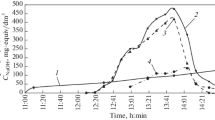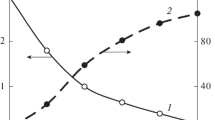Abstract
It is demonstrated that reverse osmosis (RO) technology with two stages with respect to filtrate and without any additional water treatment is adequate for makeup water treatment for natural circulation drum boilers with an operating pressure as high as 13.8 MPa. Production of filtrate with electric conductivity below 2 μS/cm, which can be used for the preparation of make-up water without ion exchange processes, can reduce capital and operating expenditures and improve the reliability of water treatment systems at thermal power stations where feasible and appropriate. Application of monotechnology, i.e., reverse osmosis, can reduce the load of engineering personnel and improve the operation stability of a water treatment unit even under conditions of seasonal variation in the analysis of raw water. The paper demonstrates that a stable decrease in the salt content by a factor of 1000 can be achieved under certain conditions with a salt content in natural raw water as high as 1 g/dm3. The effect of carbon dioxide that makes it more difficult to produce water with very low electrical conductivity is considered. Methods are described for effective removal of carbon dioxide, including decarbonization with the use of an ejector. The presented expressions enable us to quickly evaluate the salt content of the filtrate depending on the selectivity of a membrane element (ME), even determined experimentally; to solve the inverse problem, i.e., calculate the true selectivity of ME based on the measured parameters that cannot be calculated using standard software of ME manufacturers; in developing new projects, consider a decrease in the ME selectivity during operation using available experimental data on ME performance; and to predict quality and improve operation of the overall demineralization system in water treatment plants (WTP). The mathematical substantiation and the theoretical limit for application of the examined technology with respect to the salt content of the source water are presented. The results of the experiments on the use of this technology at the sites of operating thermal power stations (TPS) without decoding the latter are given.







Similar content being viewed by others
REFERENCES
A. A. Panteleev, B. E. Ryabchikov, O. V. Khoruzhii, S. L. Gromov, and A. R. Sidorov, Membrane Separation Technologies in Industrial Water Treatment (DeLi Plyus, Moscow, 2012) [in Russian].
Rules of Technical Operation of Power Plants and Networks of the Russian Federation, Order of the Ministry of Energy of Russia of June 19, 2003, No. 229. http:// base.garant.ru/186039/.
Technical Guide to Design of DOW Chemical Reverse Osmosis Units, 609-00071-104 (2004).
B. E. Ryabchikov, Modern Water Treatment (DeLi Plyus, Moscow, 2013) [in Russian].
Author information
Authors and Affiliations
Corresponding authors
Additional information
Translated by T. Krasnoshchekova
Rights and permissions
About this article
Cite this article
Panteleev, A.A., Smirnov, A.A. & Smirnov, V.B. Treatment of Makeup Water for Drum Boilers by the Two-Stage Reverse Osmosis Method. Therm. Eng. 66, 450–456 (2019). https://doi.org/10.1134/S0040601519060053
Received:
Revised:
Accepted:
Published:
Issue Date:
DOI: https://doi.org/10.1134/S0040601519060053




